Reflective Essay: Primary Teaching and Community of Practice
VerifiedAdded on 2023/06/05
|16
|4164
|215
Essay
AI Summary
This reflective essay explores the author's journey as a primary school teacher, emphasizing the challenges and triumphs within communities of practice. The essay details the author's initial experiences with marginalization due to language and cultural differences, highlighting the communication gaps and feelings of inadequacy that arose. It discusses the importance of bi-directional learning, drawing on Lave and Wenger's theory, and how active participation and collaboration with peers and supervisors helped overcome these challenges. The essay further examines the shift from peripheral to central participation, focusing on building cultural competence and fostering innovative pedagogical approaches. The second part of the essay delves into the concept of community learners, contrasting traditional teacher-centered learning with the child-driven approach advocated by Rogoff and Nimmo. It reflects on the author's past learning experiences and aspirations to create a balanced learning environment that promotes both autonomy and control, emphasizing the importance of shared endeavors between teachers and students. The essay concludes by advocating for a community of learners model where both mature and less mature members actively participate in the learning process, facilitating the exchange of ideas and fostering an inclusive educational environment.
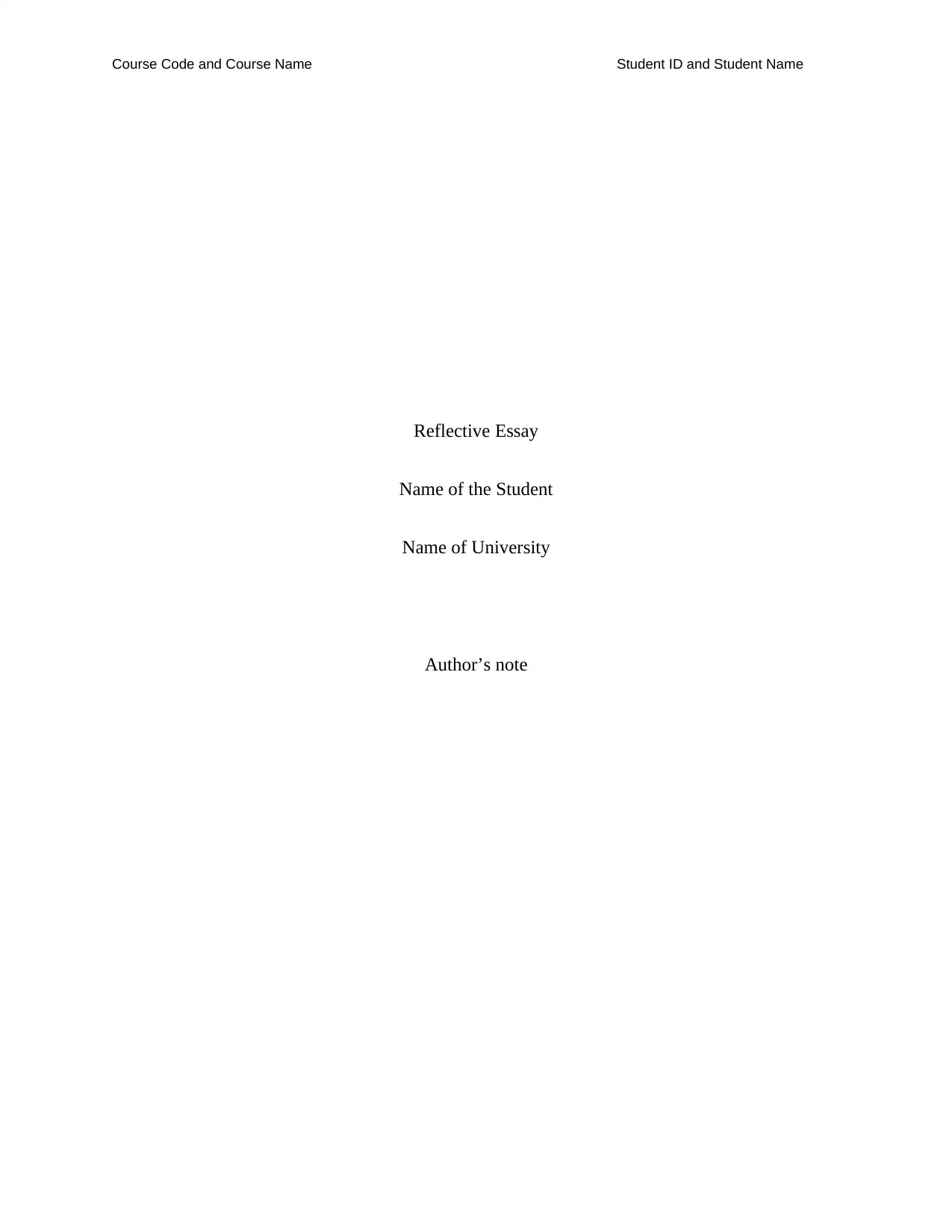
Course Code and Course Name Student ID and Student Name
Reflective Essay
Name of the Student
Name of University
Author’s note
Reflective Essay
Name of the Student
Name of University
Author’s note
Secure Best Marks with AI Grader
Need help grading? Try our AI Grader for instant feedback on your assignments.
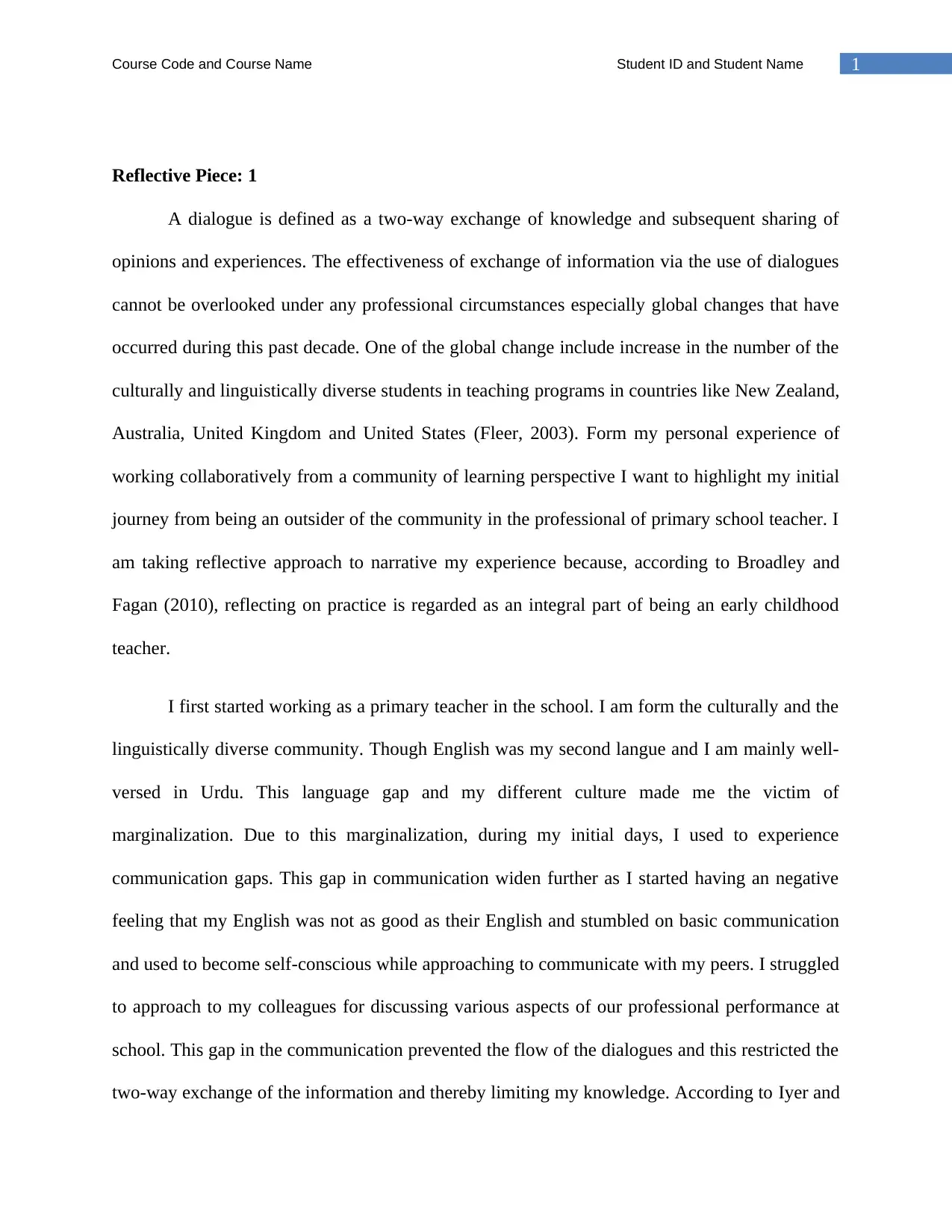
1Course Code and Course Name Student ID and Student Name
Reflective Piece: 1
A dialogue is defined as a two-way exchange of knowledge and subsequent sharing of
opinions and experiences. The effectiveness of exchange of information via the use of dialogues
cannot be overlooked under any professional circumstances especially global changes that have
occurred during this past decade. One of the global change include increase in the number of the
culturally and linguistically diverse students in teaching programs in countries like New Zealand,
Australia, United Kingdom and United States (Fleer, 2003). Form my personal experience of
working collaboratively from a community of learning perspective I want to highlight my initial
journey from being an outsider of the community in the professional of primary school teacher. I
am taking reflective approach to narrative my experience because, according to Broadley and
Fagan (2010), reflecting on practice is regarded as an integral part of being an early childhood
teacher.
I first started working as a primary teacher in the school. I am form the culturally and the
linguistically diverse community. Though English was my second langue and I am mainly well-
versed in Urdu. This language gap and my different culture made me the victim of
marginalization. Due to this marginalization, during my initial days, I used to experience
communication gaps. This gap in communication widen further as I started having an negative
feeling that my English was not as good as their English and stumbled on basic communication
and used to become self-conscious while approaching to communicate with my peers. I struggled
to approach to my colleagues for discussing various aspects of our professional performance at
school. This gap in the communication prevented the flow of the dialogues and this restricted the
two-way exchange of the information and thereby limiting my knowledge. According to Iyer and
Reflective Piece: 1
A dialogue is defined as a two-way exchange of knowledge and subsequent sharing of
opinions and experiences. The effectiveness of exchange of information via the use of dialogues
cannot be overlooked under any professional circumstances especially global changes that have
occurred during this past decade. One of the global change include increase in the number of the
culturally and linguistically diverse students in teaching programs in countries like New Zealand,
Australia, United Kingdom and United States (Fleer, 2003). Form my personal experience of
working collaboratively from a community of learning perspective I want to highlight my initial
journey from being an outsider of the community in the professional of primary school teacher. I
am taking reflective approach to narrative my experience because, according to Broadley and
Fagan (2010), reflecting on practice is regarded as an integral part of being an early childhood
teacher.
I first started working as a primary teacher in the school. I am form the culturally and the
linguistically diverse community. Though English was my second langue and I am mainly well-
versed in Urdu. This language gap and my different culture made me the victim of
marginalization. Due to this marginalization, during my initial days, I used to experience
communication gaps. This gap in communication widen further as I started having an negative
feeling that my English was not as good as their English and stumbled on basic communication
and used to become self-conscious while approaching to communicate with my peers. I struggled
to approach to my colleagues for discussing various aspects of our professional performance at
school. This gap in the communication prevented the flow of the dialogues and this restricted the
two-way exchange of the information and thereby limiting my knowledge. According to Iyer and
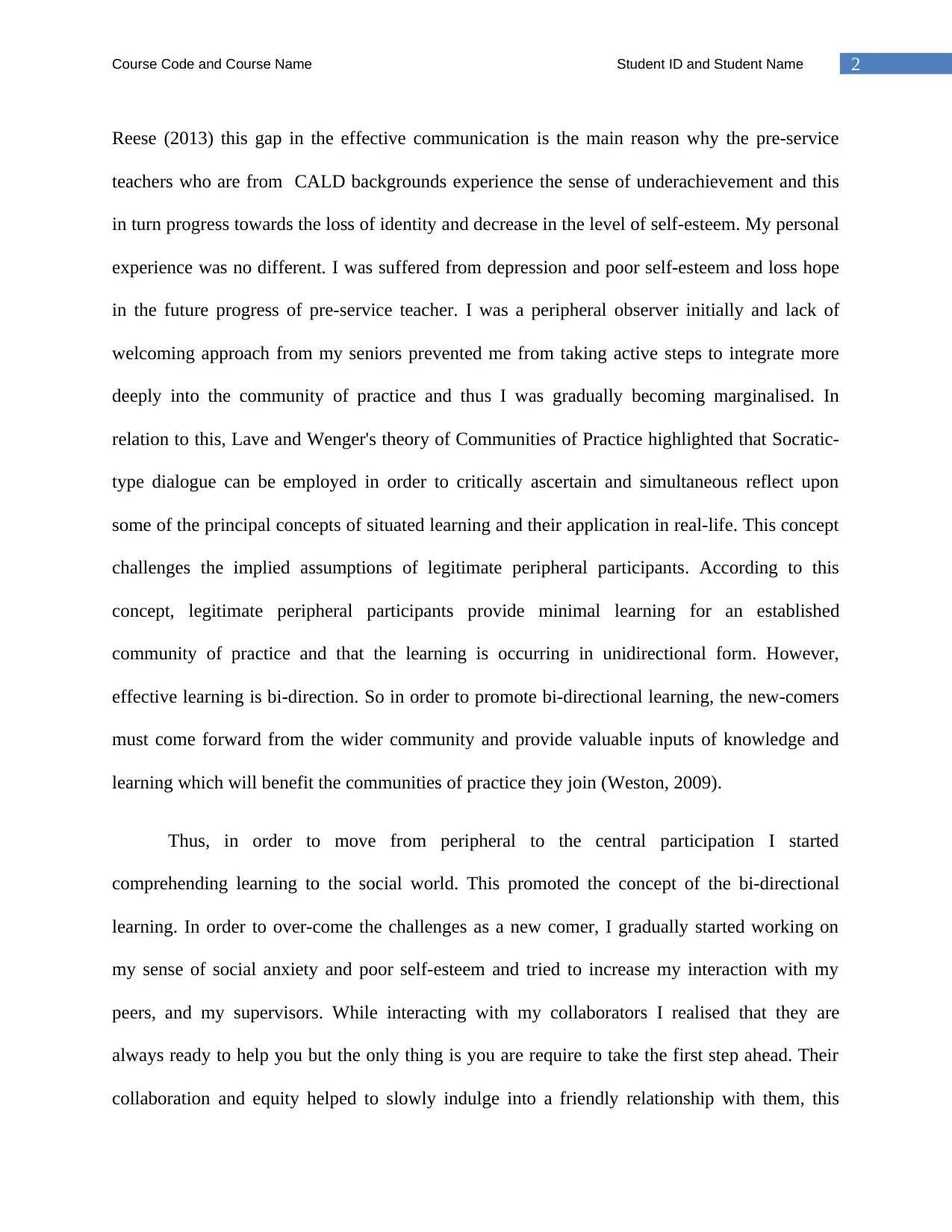
2Course Code and Course Name Student ID and Student Name
Reese (2013) this gap in the effective communication is the main reason why the pre-service
teachers who are from CALD backgrounds experience the sense of underachievement and this
in turn progress towards the loss of identity and decrease in the level of self-esteem. My personal
experience was no different. I was suffered from depression and poor self-esteem and loss hope
in the future progress of pre-service teacher. I was a peripheral observer initially and lack of
welcoming approach from my seniors prevented me from taking active steps to integrate more
deeply into the community of practice and thus I was gradually becoming marginalised. In
relation to this, Lave and Wenger's theory of Communities of Practice highlighted that Socratic-
type dialogue can be employed in order to critically ascertain and simultaneous reflect upon
some of the principal concepts of situated learning and their application in real-life. This concept
challenges the implied assumptions of legitimate peripheral participants. According to this
concept, legitimate peripheral participants provide minimal learning for an established
community of practice and that the learning is occurring in unidirectional form. However,
effective learning is bi-direction. So in order to promote bi-directional learning, the new-comers
must come forward from the wider community and provide valuable inputs of knowledge and
learning which will benefit the communities of practice they join (Weston, 2009).
Thus, in order to move from peripheral to the central participation I started
comprehending learning to the social world. This promoted the concept of the bi-directional
learning. In order to over-come the challenges as a new comer, I gradually started working on
my sense of social anxiety and poor self-esteem and tried to increase my interaction with my
peers, and my supervisors. While interacting with my collaborators I realised that they are
always ready to help you but the only thing is you are require to take the first step ahead. Their
collaboration and equity helped to slowly indulge into a friendly relationship with them, this
Reese (2013) this gap in the effective communication is the main reason why the pre-service
teachers who are from CALD backgrounds experience the sense of underachievement and this
in turn progress towards the loss of identity and decrease in the level of self-esteem. My personal
experience was no different. I was suffered from depression and poor self-esteem and loss hope
in the future progress of pre-service teacher. I was a peripheral observer initially and lack of
welcoming approach from my seniors prevented me from taking active steps to integrate more
deeply into the community of practice and thus I was gradually becoming marginalised. In
relation to this, Lave and Wenger's theory of Communities of Practice highlighted that Socratic-
type dialogue can be employed in order to critically ascertain and simultaneous reflect upon
some of the principal concepts of situated learning and their application in real-life. This concept
challenges the implied assumptions of legitimate peripheral participants. According to this
concept, legitimate peripheral participants provide minimal learning for an established
community of practice and that the learning is occurring in unidirectional form. However,
effective learning is bi-direction. So in order to promote bi-directional learning, the new-comers
must come forward from the wider community and provide valuable inputs of knowledge and
learning which will benefit the communities of practice they join (Weston, 2009).
Thus, in order to move from peripheral to the central participation I started
comprehending learning to the social world. This promoted the concept of the bi-directional
learning. In order to over-come the challenges as a new comer, I gradually started working on
my sense of social anxiety and poor self-esteem and tried to increase my interaction with my
peers, and my supervisors. While interacting with my collaborators I realised that they are
always ready to help you but the only thing is you are require to take the first step ahead. Their
collaboration and equity helped to slowly indulge into a friendly relationship with them, this
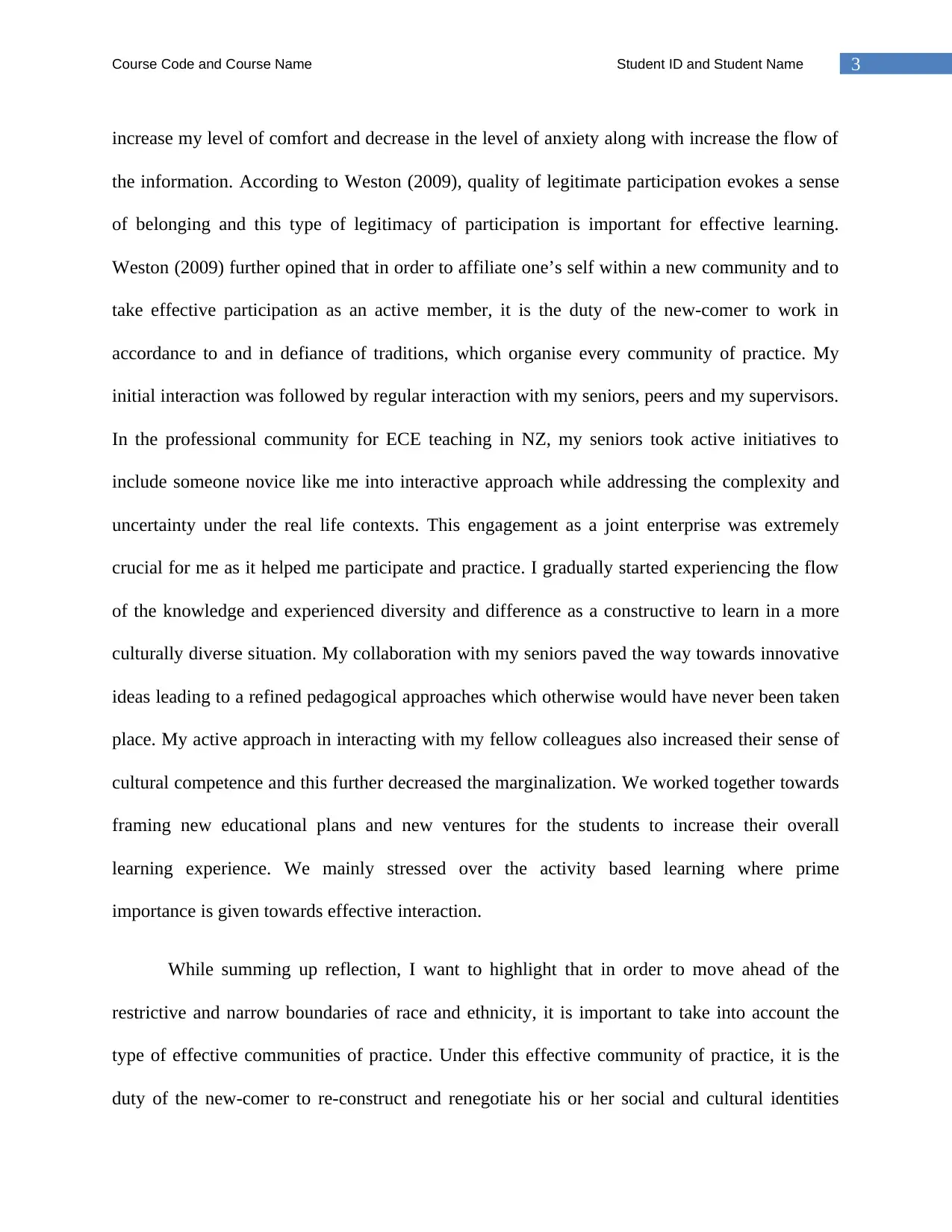
3Course Code and Course Name Student ID and Student Name
increase my level of comfort and decrease in the level of anxiety along with increase the flow of
the information. According to Weston (2009), quality of legitimate participation evokes a sense
of belonging and this type of legitimacy of participation is important for effective learning.
Weston (2009) further opined that in order to affiliate one’s self within a new community and to
take effective participation as an active member, it is the duty of the new-comer to work in
accordance to and in defiance of traditions, which organise every community of practice. My
initial interaction was followed by regular interaction with my seniors, peers and my supervisors.
In the professional community for ECE teaching in NZ, my seniors took active initiatives to
include someone novice like me into interactive approach while addressing the complexity and
uncertainty under the real life contexts. This engagement as a joint enterprise was extremely
crucial for me as it helped me participate and practice. I gradually started experiencing the flow
of the knowledge and experienced diversity and difference as a constructive to learn in a more
culturally diverse situation. My collaboration with my seniors paved the way towards innovative
ideas leading to a refined pedagogical approaches which otherwise would have never been taken
place. My active approach in interacting with my fellow colleagues also increased their sense of
cultural competence and this further decreased the marginalization. We worked together towards
framing new educational plans and new ventures for the students to increase their overall
learning experience. We mainly stressed over the activity based learning where prime
importance is given towards effective interaction.
While summing up reflection, I want to highlight that in order to move ahead of the
restrictive and narrow boundaries of race and ethnicity, it is important to take into account the
type of effective communities of practice. Under this effective community of practice, it is the
duty of the new-comer to re-construct and renegotiate his or her social and cultural identities
increase my level of comfort and decrease in the level of anxiety along with increase the flow of
the information. According to Weston (2009), quality of legitimate participation evokes a sense
of belonging and this type of legitimacy of participation is important for effective learning.
Weston (2009) further opined that in order to affiliate one’s self within a new community and to
take effective participation as an active member, it is the duty of the new-comer to work in
accordance to and in defiance of traditions, which organise every community of practice. My
initial interaction was followed by regular interaction with my seniors, peers and my supervisors.
In the professional community for ECE teaching in NZ, my seniors took active initiatives to
include someone novice like me into interactive approach while addressing the complexity and
uncertainty under the real life contexts. This engagement as a joint enterprise was extremely
crucial for me as it helped me participate and practice. I gradually started experiencing the flow
of the knowledge and experienced diversity and difference as a constructive to learn in a more
culturally diverse situation. My collaboration with my seniors paved the way towards innovative
ideas leading to a refined pedagogical approaches which otherwise would have never been taken
place. My active approach in interacting with my fellow colleagues also increased their sense of
cultural competence and this further decreased the marginalization. We worked together towards
framing new educational plans and new ventures for the students to increase their overall
learning experience. We mainly stressed over the activity based learning where prime
importance is given towards effective interaction.
While summing up reflection, I want to highlight that in order to move ahead of the
restrictive and narrow boundaries of race and ethnicity, it is important to take into account the
type of effective communities of practice. Under this effective community of practice, it is the
duty of the new-comer to re-construct and renegotiate his or her social and cultural identities
Secure Best Marks with AI Grader
Need help grading? Try our AI Grader for instant feedback on your assignments.
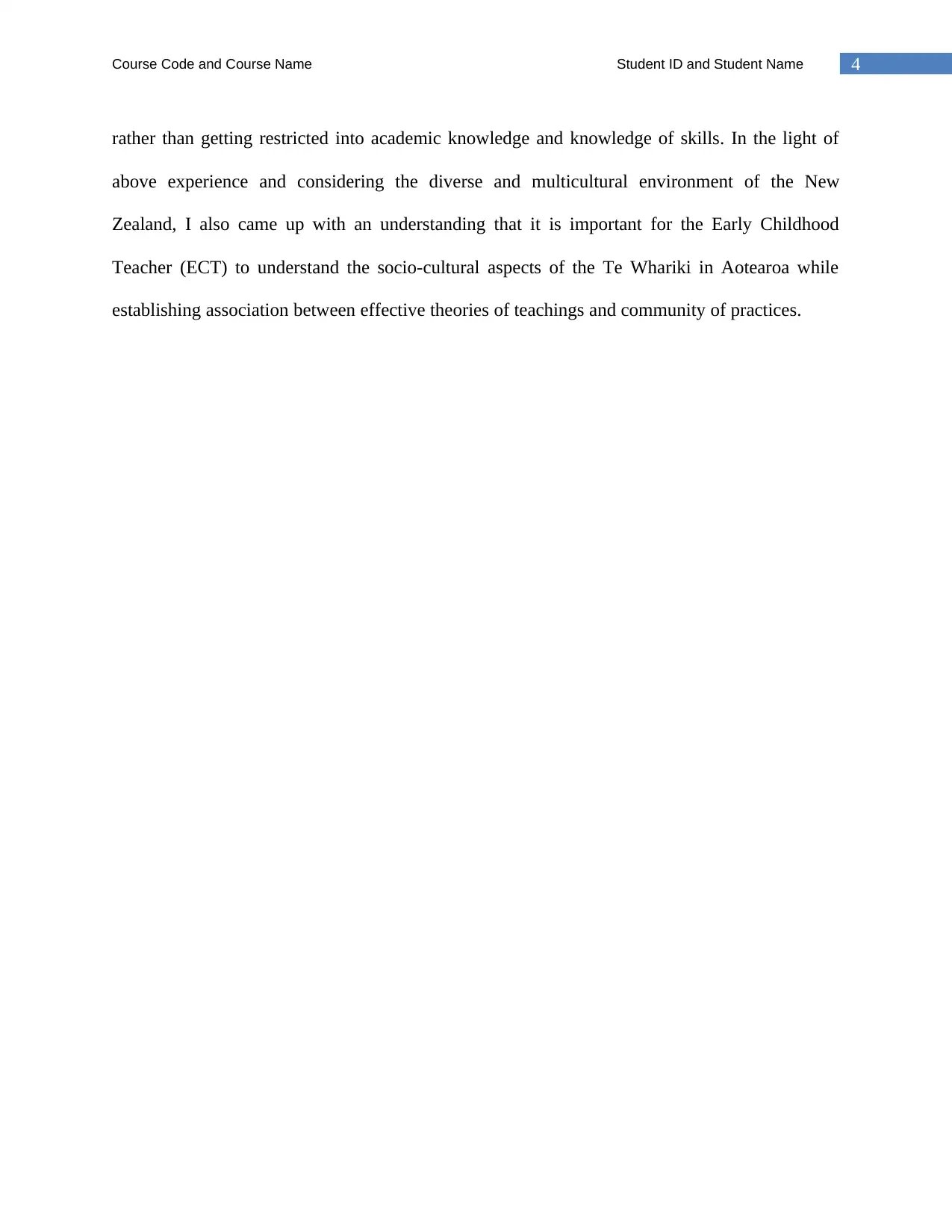
4Course Code and Course Name Student ID and Student Name
rather than getting restricted into academic knowledge and knowledge of skills. In the light of
above experience and considering the diverse and multicultural environment of the New
Zealand, I also came up with an understanding that it is important for the Early Childhood
Teacher (ECT) to understand the socio-cultural aspects of the Te Whariki in Aotearoa while
establishing association between effective theories of teachings and community of practices.
rather than getting restricted into academic knowledge and knowledge of skills. In the light of
above experience and considering the diverse and multicultural environment of the New
Zealand, I also came up with an understanding that it is important for the Early Childhood
Teacher (ECT) to understand the socio-cultural aspects of the Te Whariki in Aotearoa while
establishing association between effective theories of teachings and community of practices.
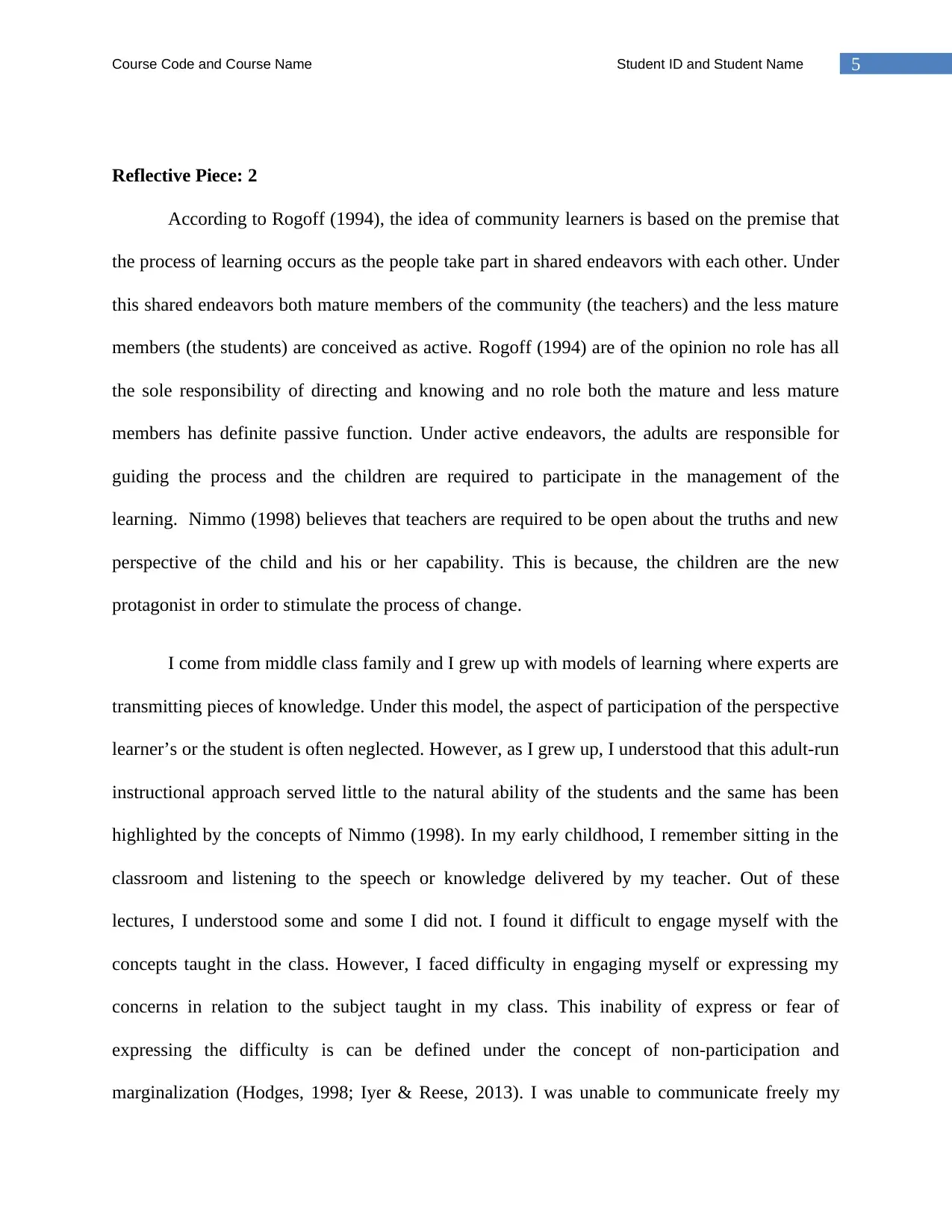
5Course Code and Course Name Student ID and Student Name
Reflective Piece: 2
According to Rogoff (1994), the idea of community learners is based on the premise that
the process of learning occurs as the people take part in shared endeavors with each other. Under
this shared endeavors both mature members of the community (the teachers) and the less mature
members (the students) are conceived as active. Rogoff (1994) are of the opinion no role has all
the sole responsibility of directing and knowing and no role both the mature and less mature
members has definite passive function. Under active endeavors, the adults are responsible for
guiding the process and the children are required to participate in the management of the
learning. Nimmo (1998) believes that teachers are required to be open about the truths and new
perspective of the child and his or her capability. This is because, the children are the new
protagonist in order to stimulate the process of change.
I come from middle class family and I grew up with models of learning where experts are
transmitting pieces of knowledge. Under this model, the aspect of participation of the perspective
learner’s or the student is often neglected. However, as I grew up, I understood that this adult-run
instructional approach served little to the natural ability of the students and the same has been
highlighted by the concepts of Nimmo (1998). In my early childhood, I remember sitting in the
classroom and listening to the speech or knowledge delivered by my teacher. Out of these
lectures, I understood some and some I did not. I found it difficult to engage myself with the
concepts taught in the class. However, I faced difficulty in engaging myself or expressing my
concerns in relation to the subject taught in my class. This inability of express or fear of
expressing the difficulty is can be defined under the concept of non-participation and
marginalization (Hodges, 1998; Iyer & Reese, 2013). I was unable to communicate freely my
Reflective Piece: 2
According to Rogoff (1994), the idea of community learners is based on the premise that
the process of learning occurs as the people take part in shared endeavors with each other. Under
this shared endeavors both mature members of the community (the teachers) and the less mature
members (the students) are conceived as active. Rogoff (1994) are of the opinion no role has all
the sole responsibility of directing and knowing and no role both the mature and less mature
members has definite passive function. Under active endeavors, the adults are responsible for
guiding the process and the children are required to participate in the management of the
learning. Nimmo (1998) believes that teachers are required to be open about the truths and new
perspective of the child and his or her capability. This is because, the children are the new
protagonist in order to stimulate the process of change.
I come from middle class family and I grew up with models of learning where experts are
transmitting pieces of knowledge. Under this model, the aspect of participation of the perspective
learner’s or the student is often neglected. However, as I grew up, I understood that this adult-run
instructional approach served little to the natural ability of the students and the same has been
highlighted by the concepts of Nimmo (1998). In my early childhood, I remember sitting in the
classroom and listening to the speech or knowledge delivered by my teacher. Out of these
lectures, I understood some and some I did not. I found it difficult to engage myself with the
concepts taught in the class. However, I faced difficulty in engaging myself or expressing my
concerns in relation to the subject taught in my class. This inability of express or fear of
expressing the difficulty is can be defined under the concept of non-participation and
marginalization (Hodges, 1998; Iyer & Reese, 2013). I was unable to communicate freely my
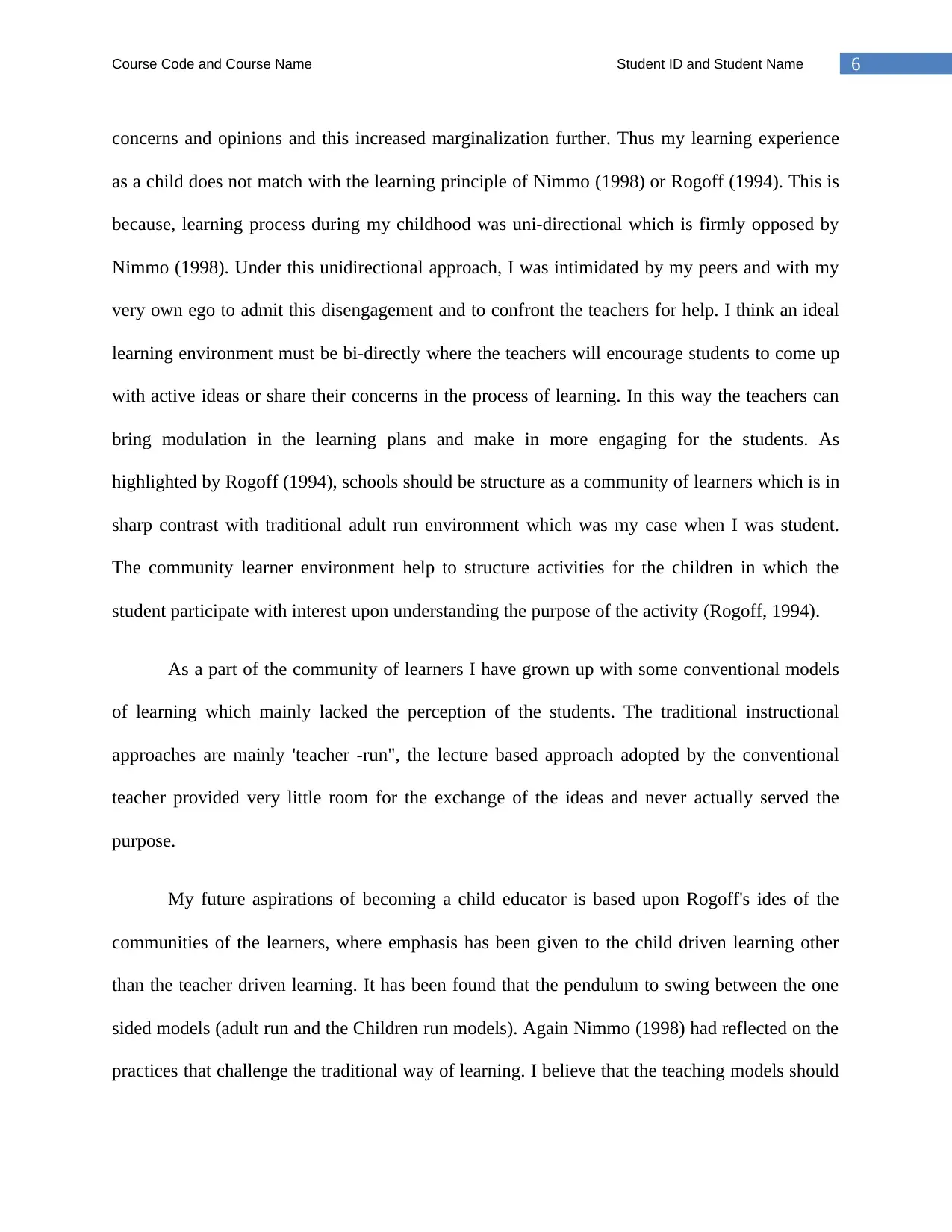
6Course Code and Course Name Student ID and Student Name
concerns and opinions and this increased marginalization further. Thus my learning experience
as a child does not match with the learning principle of Nimmo (1998) or Rogoff (1994). This is
because, learning process during my childhood was uni-directional which is firmly opposed by
Nimmo (1998). Under this unidirectional approach, I was intimidated by my peers and with my
very own ego to admit this disengagement and to confront the teachers for help. I think an ideal
learning environment must be bi-directly where the teachers will encourage students to come up
with active ideas or share their concerns in the process of learning. In this way the teachers can
bring modulation in the learning plans and make in more engaging for the students. As
highlighted by Rogoff (1994), schools should be structure as a community of learners which is in
sharp contrast with traditional adult run environment which was my case when I was student.
The community learner environment help to structure activities for the children in which the
student participate with interest upon understanding the purpose of the activity (Rogoff, 1994).
As a part of the community of learners I have grown up with some conventional models
of learning which mainly lacked the perception of the students. The traditional instructional
approaches are mainly 'teacher -run", the lecture based approach adopted by the conventional
teacher provided very little room for the exchange of the ideas and never actually served the
purpose.
My future aspirations of becoming a child educator is based upon Rogoff's ides of the
communities of the learners, where emphasis has been given to the child driven learning other
than the teacher driven learning. It has been found that the pendulum to swing between the one
sided models (adult run and the Children run models). Again Nimmo (1998) had reflected on the
practices that challenge the traditional way of learning. I believe that the teaching models should
concerns and opinions and this increased marginalization further. Thus my learning experience
as a child does not match with the learning principle of Nimmo (1998) or Rogoff (1994). This is
because, learning process during my childhood was uni-directional which is firmly opposed by
Nimmo (1998). Under this unidirectional approach, I was intimidated by my peers and with my
very own ego to admit this disengagement and to confront the teachers for help. I think an ideal
learning environment must be bi-directly where the teachers will encourage students to come up
with active ideas or share their concerns in the process of learning. In this way the teachers can
bring modulation in the learning plans and make in more engaging for the students. As
highlighted by Rogoff (1994), schools should be structure as a community of learners which is in
sharp contrast with traditional adult run environment which was my case when I was student.
The community learner environment help to structure activities for the children in which the
student participate with interest upon understanding the purpose of the activity (Rogoff, 1994).
As a part of the community of learners I have grown up with some conventional models
of learning which mainly lacked the perception of the students. The traditional instructional
approaches are mainly 'teacher -run", the lecture based approach adopted by the conventional
teacher provided very little room for the exchange of the ideas and never actually served the
purpose.
My future aspirations of becoming a child educator is based upon Rogoff's ides of the
communities of the learners, where emphasis has been given to the child driven learning other
than the teacher driven learning. It has been found that the pendulum to swing between the one
sided models (adult run and the Children run models). Again Nimmo (1998) had reflected on the
practices that challenge the traditional way of learning. I believe that the teaching models should
Paraphrase This Document
Need a fresh take? Get an instant paraphrase of this document with our AI Paraphraser
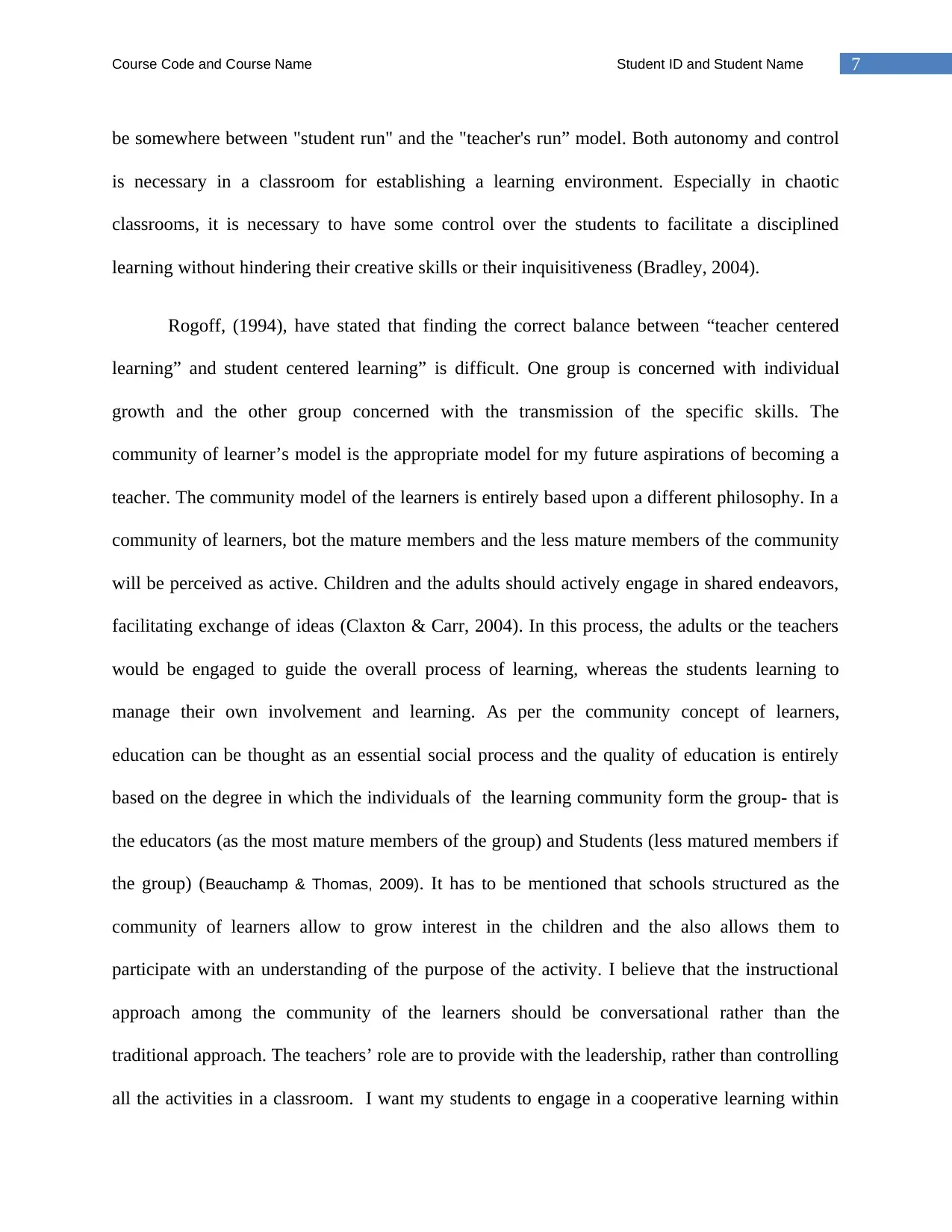
7Course Code and Course Name Student ID and Student Name
be somewhere between "student run" and the "teacher's run” model. Both autonomy and control
is necessary in a classroom for establishing a learning environment. Especially in chaotic
classrooms, it is necessary to have some control over the students to facilitate a disciplined
learning without hindering their creative skills or their inquisitiveness (Bradley, 2004).
Rogoff, (1994), have stated that finding the correct balance between “teacher centered
learning” and student centered learning” is difficult. One group is concerned with individual
growth and the other group concerned with the transmission of the specific skills. The
community of learner’s model is the appropriate model for my future aspirations of becoming a
teacher. The community model of the learners is entirely based upon a different philosophy. In a
community of learners, bot the mature members and the less mature members of the community
will be perceived as active. Children and the adults should actively engage in shared endeavors,
facilitating exchange of ideas (Claxton & Carr, 2004). In this process, the adults or the teachers
would be engaged to guide the overall process of learning, whereas the students learning to
manage their own involvement and learning. As per the community concept of learners,
education can be thought as an essential social process and the quality of education is entirely
based on the degree in which the individuals of the learning community form the group- that is
the educators (as the most mature members of the group) and Students (less matured members if
the group) (Beauchamp & Thomas, 2009). It has to be mentioned that schools structured as the
community of learners allow to grow interest in the children and the also allows them to
participate with an understanding of the purpose of the activity. I believe that the instructional
approach among the community of the learners should be conversational rather than the
traditional approach. The teachers’ role are to provide with the leadership, rather than controlling
all the activities in a classroom. I want my students to engage in a cooperative learning within
be somewhere between "student run" and the "teacher's run” model. Both autonomy and control
is necessary in a classroom for establishing a learning environment. Especially in chaotic
classrooms, it is necessary to have some control over the students to facilitate a disciplined
learning without hindering their creative skills or their inquisitiveness (Bradley, 2004).
Rogoff, (1994), have stated that finding the correct balance between “teacher centered
learning” and student centered learning” is difficult. One group is concerned with individual
growth and the other group concerned with the transmission of the specific skills. The
community of learner’s model is the appropriate model for my future aspirations of becoming a
teacher. The community model of the learners is entirely based upon a different philosophy. In a
community of learners, bot the mature members and the less mature members of the community
will be perceived as active. Children and the adults should actively engage in shared endeavors,
facilitating exchange of ideas (Claxton & Carr, 2004). In this process, the adults or the teachers
would be engaged to guide the overall process of learning, whereas the students learning to
manage their own involvement and learning. As per the community concept of learners,
education can be thought as an essential social process and the quality of education is entirely
based on the degree in which the individuals of the learning community form the group- that is
the educators (as the most mature members of the group) and Students (less matured members if
the group) (Beauchamp & Thomas, 2009). It has to be mentioned that schools structured as the
community of learners allow to grow interest in the children and the also allows them to
participate with an understanding of the purpose of the activity. I believe that the instructional
approach among the community of the learners should be conversational rather than the
traditional approach. The teachers’ role are to provide with the leadership, rather than controlling
all the activities in a classroom. I want my students to engage in a cooperative learning within
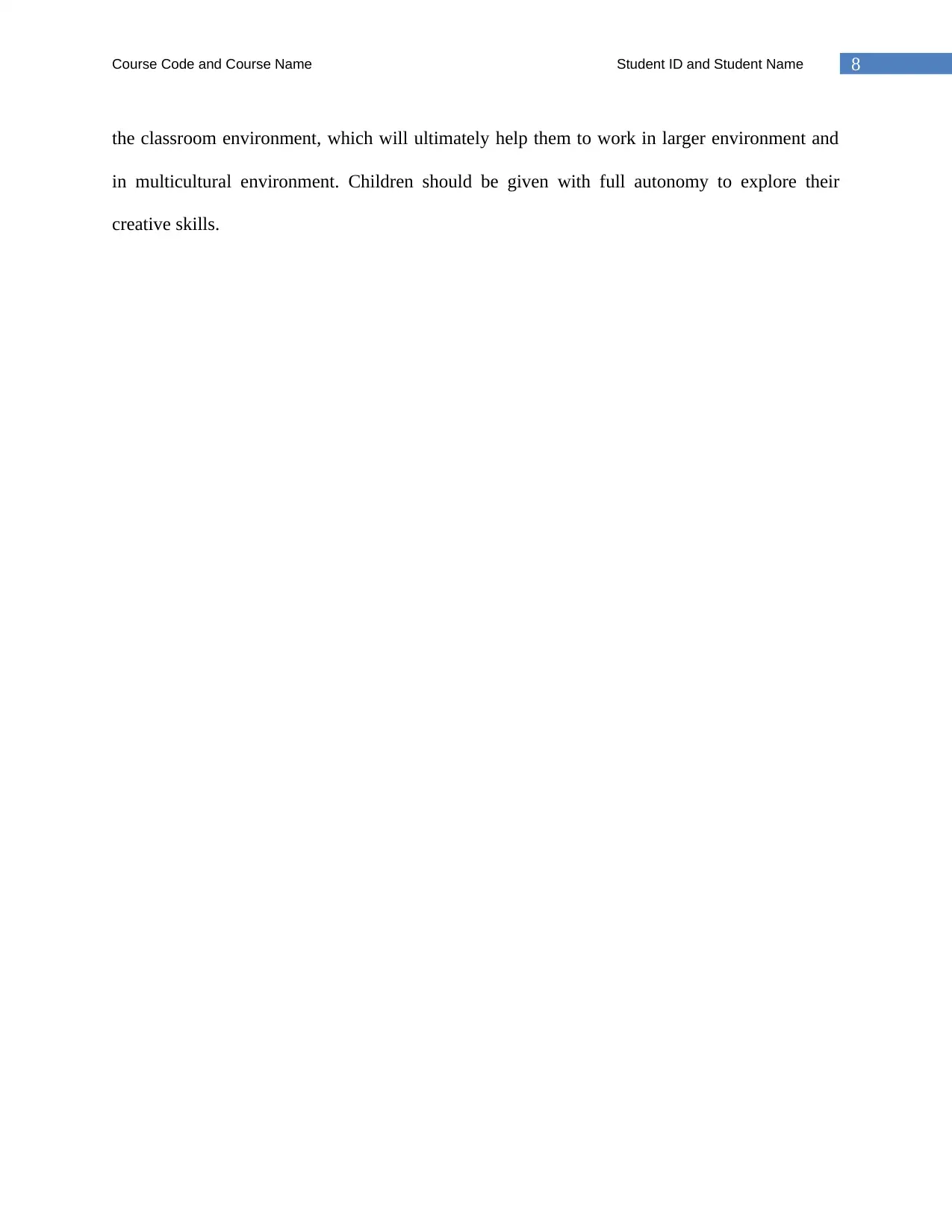
8Course Code and Course Name Student ID and Student Name
the classroom environment, which will ultimately help them to work in larger environment and
in multicultural environment. Children should be given with full autonomy to explore their
creative skills.
the classroom environment, which will ultimately help them to work in larger environment and
in multicultural environment. Children should be given with full autonomy to explore their
creative skills.
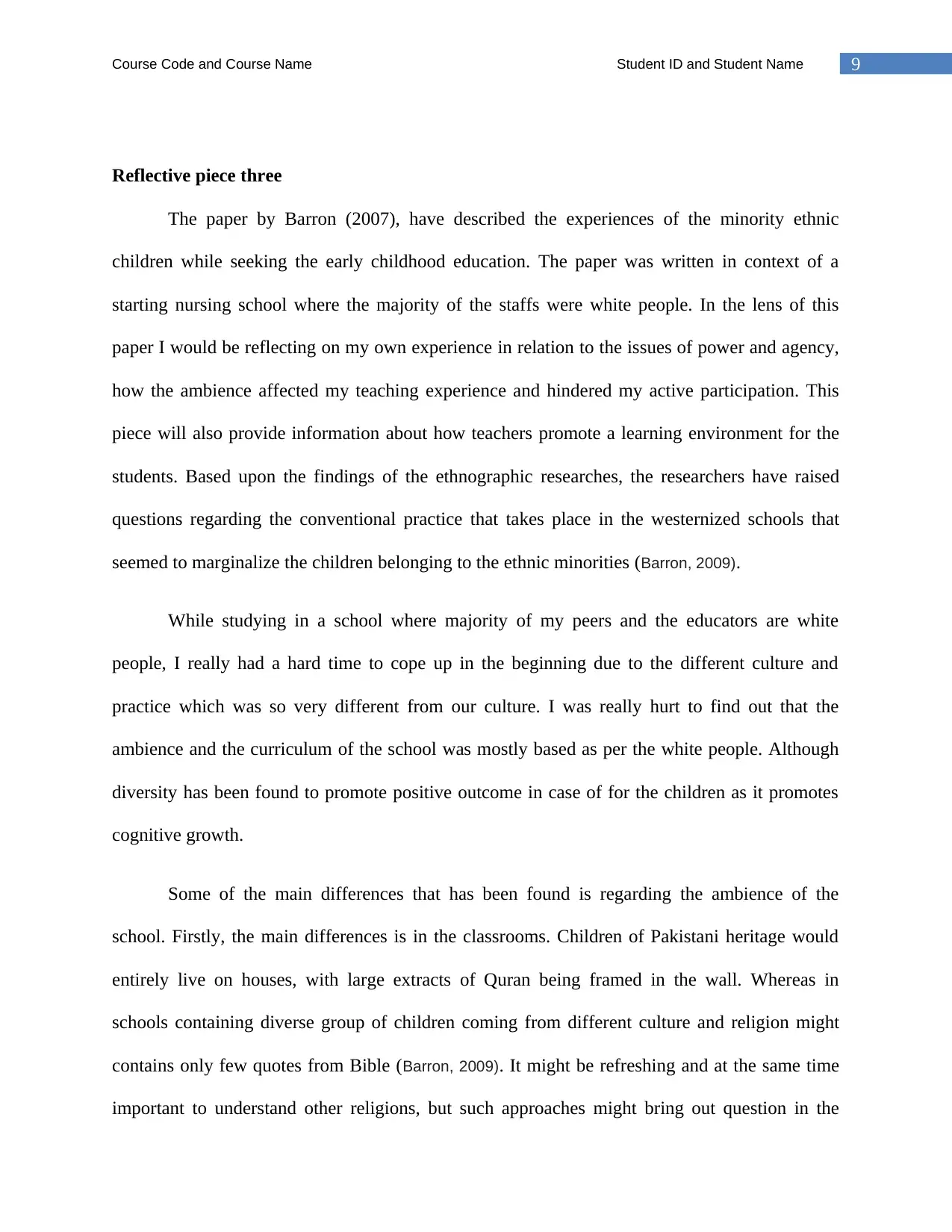
9Course Code and Course Name Student ID and Student Name
Reflective piece three
The paper by Barron (2007), have described the experiences of the minority ethnic
children while seeking the early childhood education. The paper was written in context of a
starting nursing school where the majority of the staffs were white people. In the lens of this
paper I would be reflecting on my own experience in relation to the issues of power and agency,
how the ambience affected my teaching experience and hindered my active participation. This
piece will also provide information about how teachers promote a learning environment for the
students. Based upon the findings of the ethnographic researches, the researchers have raised
questions regarding the conventional practice that takes place in the westernized schools that
seemed to marginalize the children belonging to the ethnic minorities (Barron, 2009).
While studying in a school where majority of my peers and the educators are white
people, I really had a hard time to cope up in the beginning due to the different culture and
practice which was so very different from our culture. I was really hurt to find out that the
ambience and the curriculum of the school was mostly based as per the white people. Although
diversity has been found to promote positive outcome in case of for the children as it promotes
cognitive growth.
Some of the main differences that has been found is regarding the ambience of the
school. Firstly, the main differences is in the classrooms. Children of Pakistani heritage would
entirely live on houses, with large extracts of Quran being framed in the wall. Whereas in
schools containing diverse group of children coming from different culture and religion might
contains only few quotes from Bible (Barron, 2009). It might be refreshing and at the same time
important to understand other religions, but such approaches might bring out question in the
Reflective piece three
The paper by Barron (2007), have described the experiences of the minority ethnic
children while seeking the early childhood education. The paper was written in context of a
starting nursing school where the majority of the staffs were white people. In the lens of this
paper I would be reflecting on my own experience in relation to the issues of power and agency,
how the ambience affected my teaching experience and hindered my active participation. This
piece will also provide information about how teachers promote a learning environment for the
students. Based upon the findings of the ethnographic researches, the researchers have raised
questions regarding the conventional practice that takes place in the westernized schools that
seemed to marginalize the children belonging to the ethnic minorities (Barron, 2009).
While studying in a school where majority of my peers and the educators are white
people, I really had a hard time to cope up in the beginning due to the different culture and
practice which was so very different from our culture. I was really hurt to find out that the
ambience and the curriculum of the school was mostly based as per the white people. Although
diversity has been found to promote positive outcome in case of for the children as it promotes
cognitive growth.
Some of the main differences that has been found is regarding the ambience of the
school. Firstly, the main differences is in the classrooms. Children of Pakistani heritage would
entirely live on houses, with large extracts of Quran being framed in the wall. Whereas in
schools containing diverse group of children coming from different culture and religion might
contains only few quotes from Bible (Barron, 2009). It might be refreshing and at the same time
important to understand other religions, but such approaches might bring out question in the
Secure Best Marks with AI Grader
Need help grading? Try our AI Grader for instant feedback on your assignments.
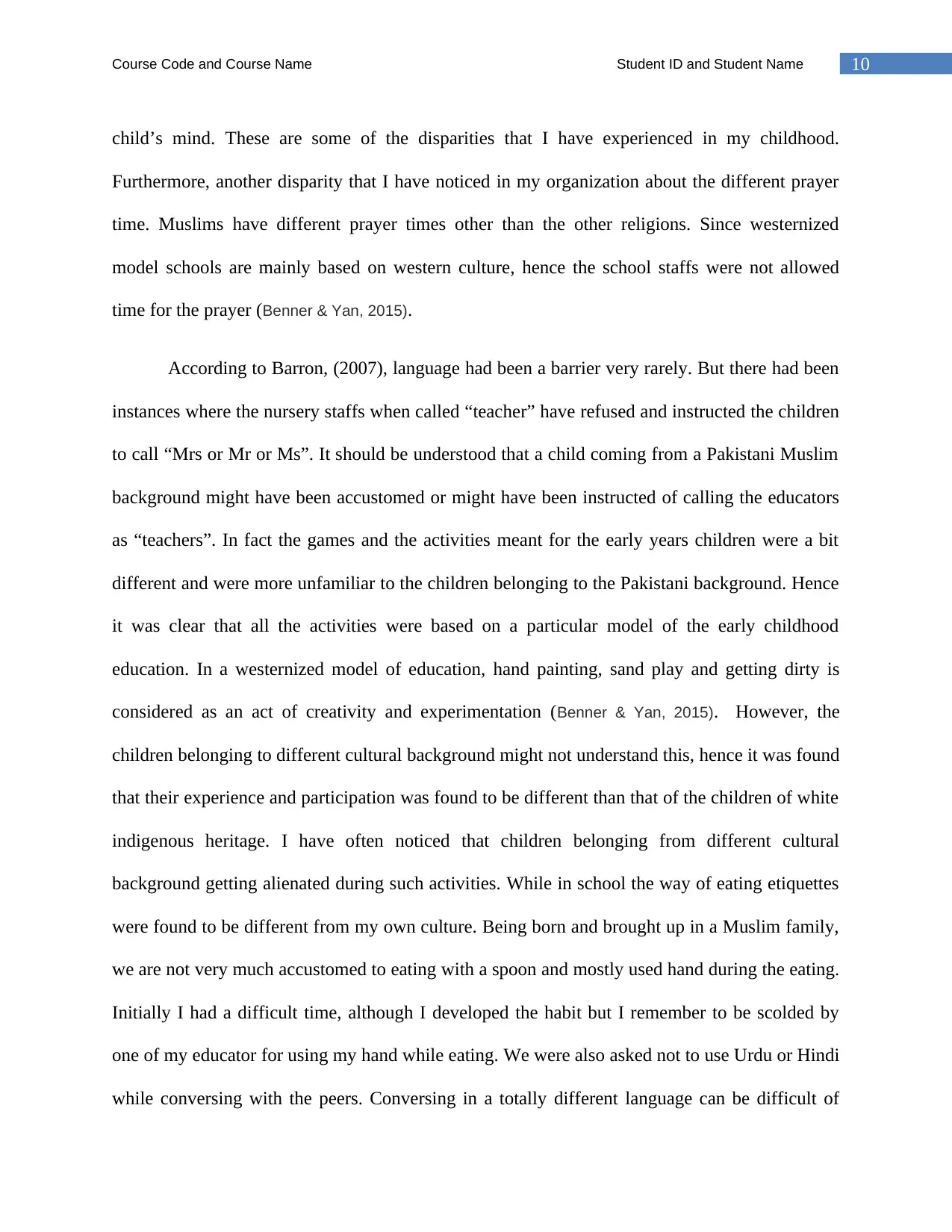
10Course Code and Course Name Student ID and Student Name
child’s mind. These are some of the disparities that I have experienced in my childhood.
Furthermore, another disparity that I have noticed in my organization about the different prayer
time. Muslims have different prayer times other than the other religions. Since westernized
model schools are mainly based on western culture, hence the school staffs were not allowed
time for the prayer (Benner & Yan, 2015).
According to Barron, (2007), language had been a barrier very rarely. But there had been
instances where the nursery staffs when called “teacher” have refused and instructed the children
to call “Mrs or Mr or Ms”. It should be understood that a child coming from a Pakistani Muslim
background might have been accustomed or might have been instructed of calling the educators
as “teachers”. In fact the games and the activities meant for the early years children were a bit
different and were more unfamiliar to the children belonging to the Pakistani background. Hence
it was clear that all the activities were based on a particular model of the early childhood
education. In a westernized model of education, hand painting, sand play and getting dirty is
considered as an act of creativity and experimentation (Benner & Yan, 2015). However, the
children belonging to different cultural background might not understand this, hence it was found
that their experience and participation was found to be different than that of the children of white
indigenous heritage. I have often noticed that children belonging from different cultural
background getting alienated during such activities. While in school the way of eating etiquettes
were found to be different from my own culture. Being born and brought up in a Muslim family,
we are not very much accustomed to eating with a spoon and mostly used hand during the eating.
Initially I had a difficult time, although I developed the habit but I remember to be scolded by
one of my educator for using my hand while eating. We were also asked not to use Urdu or Hindi
while conversing with the peers. Conversing in a totally different language can be difficult of
child’s mind. These are some of the disparities that I have experienced in my childhood.
Furthermore, another disparity that I have noticed in my organization about the different prayer
time. Muslims have different prayer times other than the other religions. Since westernized
model schools are mainly based on western culture, hence the school staffs were not allowed
time for the prayer (Benner & Yan, 2015).
According to Barron, (2007), language had been a barrier very rarely. But there had been
instances where the nursery staffs when called “teacher” have refused and instructed the children
to call “Mrs or Mr or Ms”. It should be understood that a child coming from a Pakistani Muslim
background might have been accustomed or might have been instructed of calling the educators
as “teachers”. In fact the games and the activities meant for the early years children were a bit
different and were more unfamiliar to the children belonging to the Pakistani background. Hence
it was clear that all the activities were based on a particular model of the early childhood
education. In a westernized model of education, hand painting, sand play and getting dirty is
considered as an act of creativity and experimentation (Benner & Yan, 2015). However, the
children belonging to different cultural background might not understand this, hence it was found
that their experience and participation was found to be different than that of the children of white
indigenous heritage. I have often noticed that children belonging from different cultural
background getting alienated during such activities. While in school the way of eating etiquettes
were found to be different from my own culture. Being born and brought up in a Muslim family,
we are not very much accustomed to eating with a spoon and mostly used hand during the eating.
Initially I had a difficult time, although I developed the habit but I remember to be scolded by
one of my educator for using my hand while eating. We were also asked not to use Urdu or Hindi
while conversing with the peers. Conversing in a totally different language can be difficult of
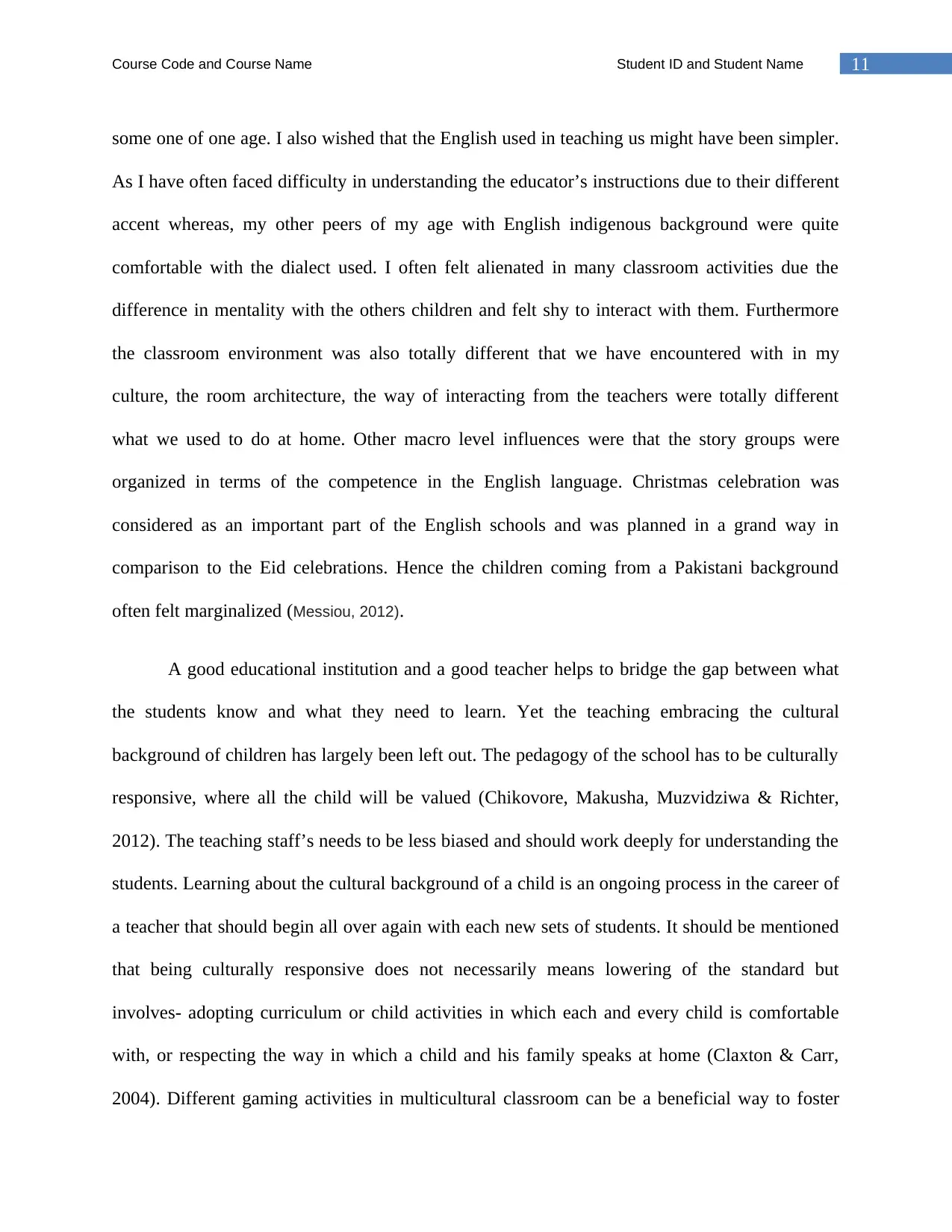
11Course Code and Course Name Student ID and Student Name
some one of one age. I also wished that the English used in teaching us might have been simpler.
As I have often faced difficulty in understanding the educator’s instructions due to their different
accent whereas, my other peers of my age with English indigenous background were quite
comfortable with the dialect used. I often felt alienated in many classroom activities due the
difference in mentality with the others children and felt shy to interact with them. Furthermore
the classroom environment was also totally different that we have encountered with in my
culture, the room architecture, the way of interacting from the teachers were totally different
what we used to do at home. Other macro level influences were that the story groups were
organized in terms of the competence in the English language. Christmas celebration was
considered as an important part of the English schools and was planned in a grand way in
comparison to the Eid celebrations. Hence the children coming from a Pakistani background
often felt marginalized (Messiou, 2012).
A good educational institution and a good teacher helps to bridge the gap between what
the students know and what they need to learn. Yet the teaching embracing the cultural
background of children has largely been left out. The pedagogy of the school has to be culturally
responsive, where all the child will be valued (Chikovore, Makusha, Muzvidziwa & Richter,
2012). The teaching staff’s needs to be less biased and should work deeply for understanding the
students. Learning about the cultural background of a child is an ongoing process in the career of
a teacher that should begin all over again with each new sets of students. It should be mentioned
that being culturally responsive does not necessarily means lowering of the standard but
involves- adopting curriculum or child activities in which each and every child is comfortable
with, or respecting the way in which a child and his family speaks at home (Claxton & Carr,
2004). Different gaming activities in multicultural classroom can be a beneficial way to foster
some one of one age. I also wished that the English used in teaching us might have been simpler.
As I have often faced difficulty in understanding the educator’s instructions due to their different
accent whereas, my other peers of my age with English indigenous background were quite
comfortable with the dialect used. I often felt alienated in many classroom activities due the
difference in mentality with the others children and felt shy to interact with them. Furthermore
the classroom environment was also totally different that we have encountered with in my
culture, the room architecture, the way of interacting from the teachers were totally different
what we used to do at home. Other macro level influences were that the story groups were
organized in terms of the competence in the English language. Christmas celebration was
considered as an important part of the English schools and was planned in a grand way in
comparison to the Eid celebrations. Hence the children coming from a Pakistani background
often felt marginalized (Messiou, 2012).
A good educational institution and a good teacher helps to bridge the gap between what
the students know and what they need to learn. Yet the teaching embracing the cultural
background of children has largely been left out. The pedagogy of the school has to be culturally
responsive, where all the child will be valued (Chikovore, Makusha, Muzvidziwa & Richter,
2012). The teaching staff’s needs to be less biased and should work deeply for understanding the
students. Learning about the cultural background of a child is an ongoing process in the career of
a teacher that should begin all over again with each new sets of students. It should be mentioned
that being culturally responsive does not necessarily means lowering of the standard but
involves- adopting curriculum or child activities in which each and every child is comfortable
with, or respecting the way in which a child and his family speaks at home (Claxton & Carr,
2004). Different gaming activities in multicultural classroom can be a beneficial way to foster
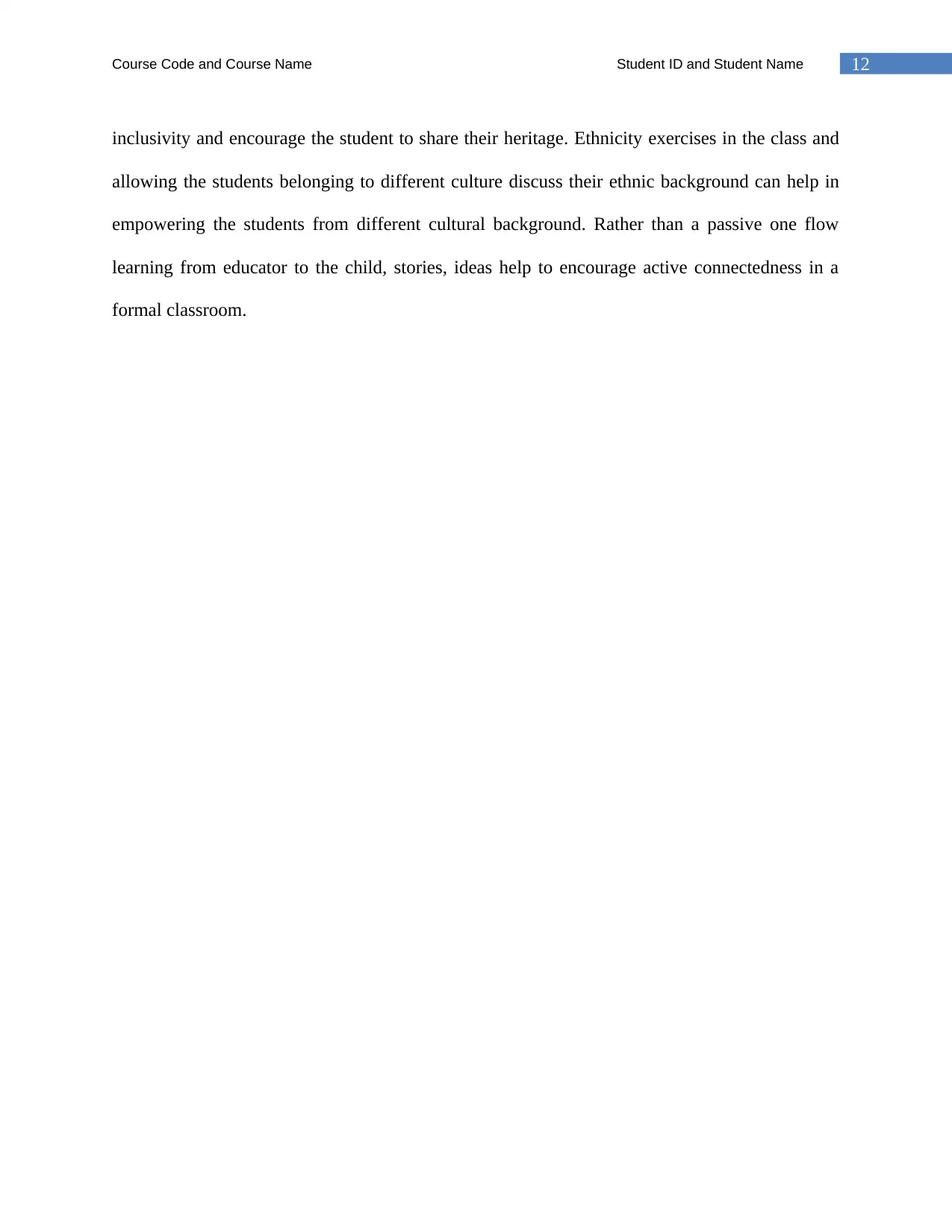
12Course Code and Course Name Student ID and Student Name
inclusivity and encourage the student to share their heritage. Ethnicity exercises in the class and
allowing the students belonging to different culture discuss their ethnic background can help in
empowering the students from different cultural background. Rather than a passive one flow
learning from educator to the child, stories, ideas help to encourage active connectedness in a
formal classroom.
inclusivity and encourage the student to share their heritage. Ethnicity exercises in the class and
allowing the students belonging to different culture discuss their ethnic background can help in
empowering the students from different cultural background. Rather than a passive one flow
learning from educator to the child, stories, ideas help to encourage active connectedness in a
formal classroom.
Paraphrase This Document
Need a fresh take? Get an instant paraphrase of this document with our AI Paraphraser
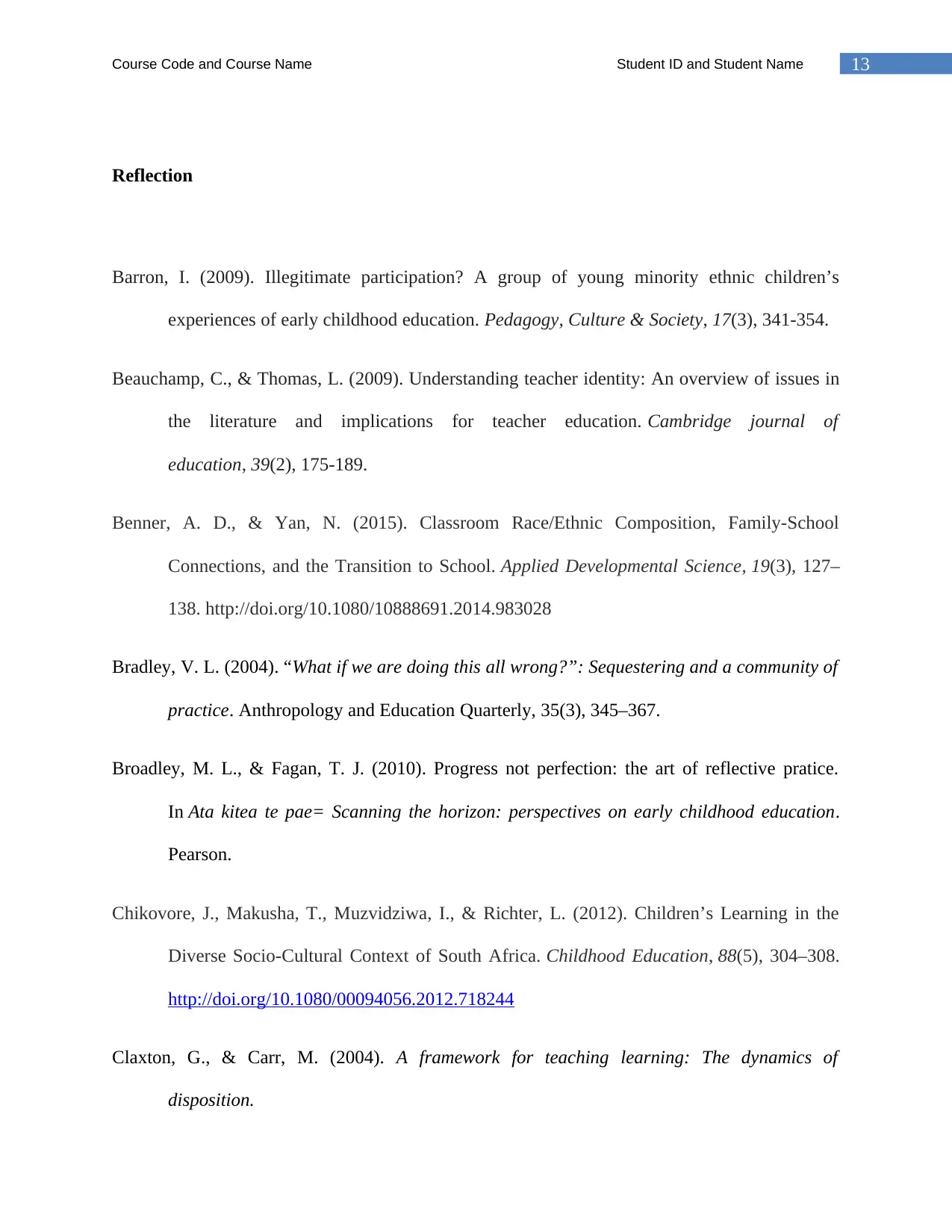
13Course Code and Course Name Student ID and Student Name
Reflection
Barron, I. (2009). Illegitimate participation? A group of young minority ethnic children’s
experiences of early childhood education. Pedagogy, Culture & Society, 17(3), 341-354.
Beauchamp, C., & Thomas, L. (2009). Understanding teacher identity: An overview of issues in
the literature and implications for teacher education. Cambridge journal of
education, 39(2), 175-189.
Benner, A. D., & Yan, N. (2015). Classroom Race/Ethnic Composition, Family-School
Connections, and the Transition to School. Applied Developmental Science, 19(3), 127–
138. http://doi.org/10.1080/10888691.2014.983028
Bradley, V. L. (2004). “What if we are doing this all wrong?”: Sequestering and a community of
practice. Anthropology and Education Quarterly, 35(3), 345–367.
Broadley, M. L., & Fagan, T. J. (2010). Progress not perfection: the art of reflective pratice.
In Ata kitea te pae= Scanning the horizon: perspectives on early childhood education.
Pearson.
Chikovore, J., Makusha, T., Muzvidziwa, I., & Richter, L. (2012). Children’s Learning in the
Diverse Socio-Cultural Context of South Africa. Childhood Education, 88(5), 304–308.
http://doi.org/10.1080/00094056.2012.718244
Claxton, G., & Carr, M. (2004). A framework for teaching learning: The dynamics of
disposition.
Reflection
Barron, I. (2009). Illegitimate participation? A group of young minority ethnic children’s
experiences of early childhood education. Pedagogy, Culture & Society, 17(3), 341-354.
Beauchamp, C., & Thomas, L. (2009). Understanding teacher identity: An overview of issues in
the literature and implications for teacher education. Cambridge journal of
education, 39(2), 175-189.
Benner, A. D., & Yan, N. (2015). Classroom Race/Ethnic Composition, Family-School
Connections, and the Transition to School. Applied Developmental Science, 19(3), 127–
138. http://doi.org/10.1080/10888691.2014.983028
Bradley, V. L. (2004). “What if we are doing this all wrong?”: Sequestering and a community of
practice. Anthropology and Education Quarterly, 35(3), 345–367.
Broadley, M. L., & Fagan, T. J. (2010). Progress not perfection: the art of reflective pratice.
In Ata kitea te pae= Scanning the horizon: perspectives on early childhood education.
Pearson.
Chikovore, J., Makusha, T., Muzvidziwa, I., & Richter, L. (2012). Children’s Learning in the
Diverse Socio-Cultural Context of South Africa. Childhood Education, 88(5), 304–308.
http://doi.org/10.1080/00094056.2012.718244
Claxton, G., & Carr, M. (2004). A framework for teaching learning: The dynamics of
disposition.
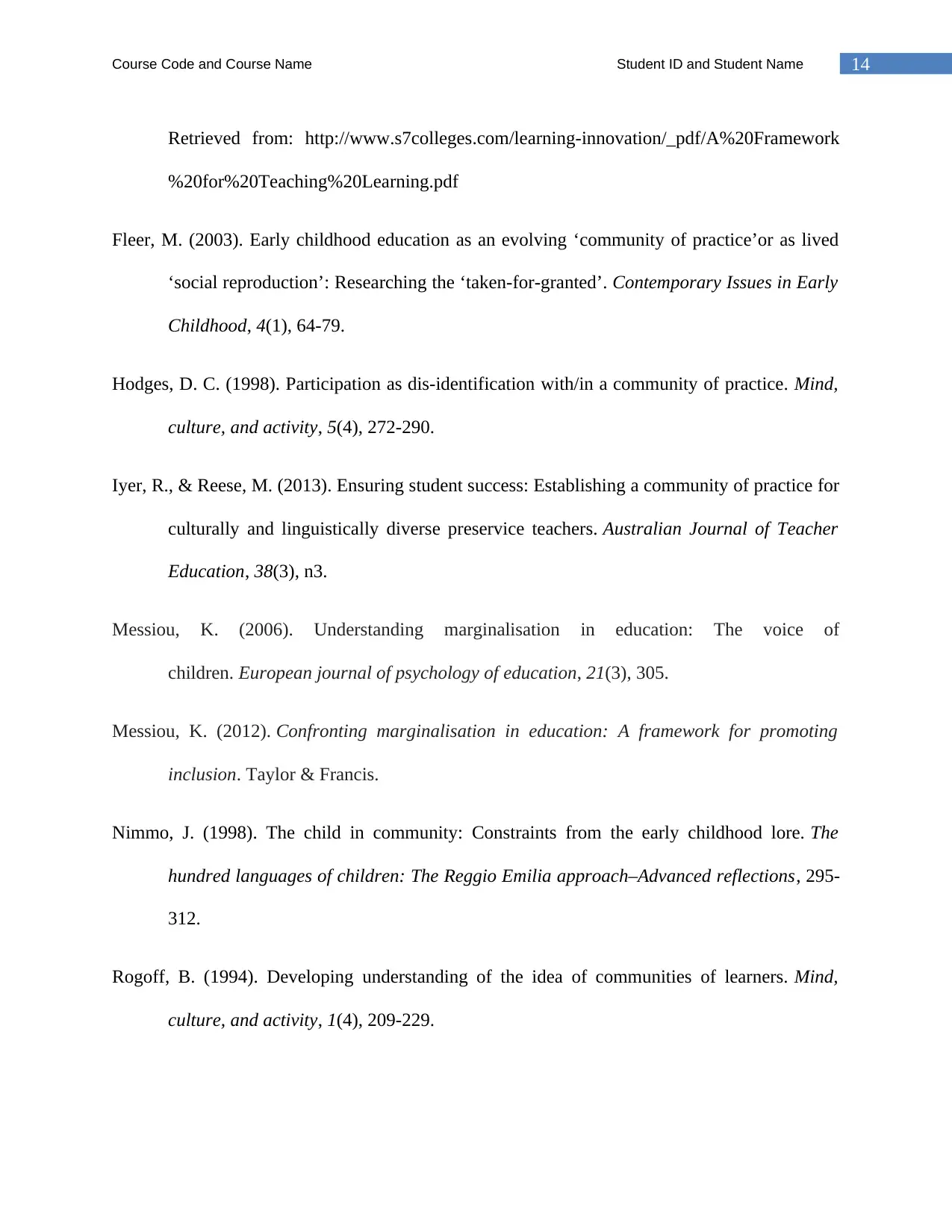
14Course Code and Course Name Student ID and Student Name
Retrieved from: http://www.s7colleges.com/learning-innovation/_pdf/A%20Framework
%20for%20Teaching%20Learning.pdf
Fleer, M. (2003). Early childhood education as an evolving ‘community of practice’or as lived
‘social reproduction’: Researching the ‘taken-for-granted’. Contemporary Issues in Early
Childhood, 4(1), 64-79.
Hodges, D. C. (1998). Participation as dis-identification with/in a community of practice. Mind,
culture, and activity, 5(4), 272-290.
Iyer, R., & Reese, M. (2013). Ensuring student success: Establishing a community of practice for
culturally and linguistically diverse preservice teachers. Australian Journal of Teacher
Education, 38(3), n3.
Messiou, K. (2006). Understanding marginalisation in education: The voice of
children. European journal of psychology of education, 21(3), 305.
Messiou, K. (2012). Confronting marginalisation in education: A framework for promoting
inclusion. Taylor & Francis.
Nimmo, J. (1998). The child in community: Constraints from the early childhood lore. The
hundred languages of children: The Reggio Emilia approach–Advanced reflections, 295-
312.
Rogoff, B. (1994). Developing understanding of the idea of communities of learners. Mind,
culture, and activity, 1(4), 209-229.
Retrieved from: http://www.s7colleges.com/learning-innovation/_pdf/A%20Framework
%20for%20Teaching%20Learning.pdf
Fleer, M. (2003). Early childhood education as an evolving ‘community of practice’or as lived
‘social reproduction’: Researching the ‘taken-for-granted’. Contemporary Issues in Early
Childhood, 4(1), 64-79.
Hodges, D. C. (1998). Participation as dis-identification with/in a community of practice. Mind,
culture, and activity, 5(4), 272-290.
Iyer, R., & Reese, M. (2013). Ensuring student success: Establishing a community of practice for
culturally and linguistically diverse preservice teachers. Australian Journal of Teacher
Education, 38(3), n3.
Messiou, K. (2006). Understanding marginalisation in education: The voice of
children. European journal of psychology of education, 21(3), 305.
Messiou, K. (2012). Confronting marginalisation in education: A framework for promoting
inclusion. Taylor & Francis.
Nimmo, J. (1998). The child in community: Constraints from the early childhood lore. The
hundred languages of children: The Reggio Emilia approach–Advanced reflections, 295-
312.
Rogoff, B. (1994). Developing understanding of the idea of communities of learners. Mind,
culture, and activity, 1(4), 209-229.
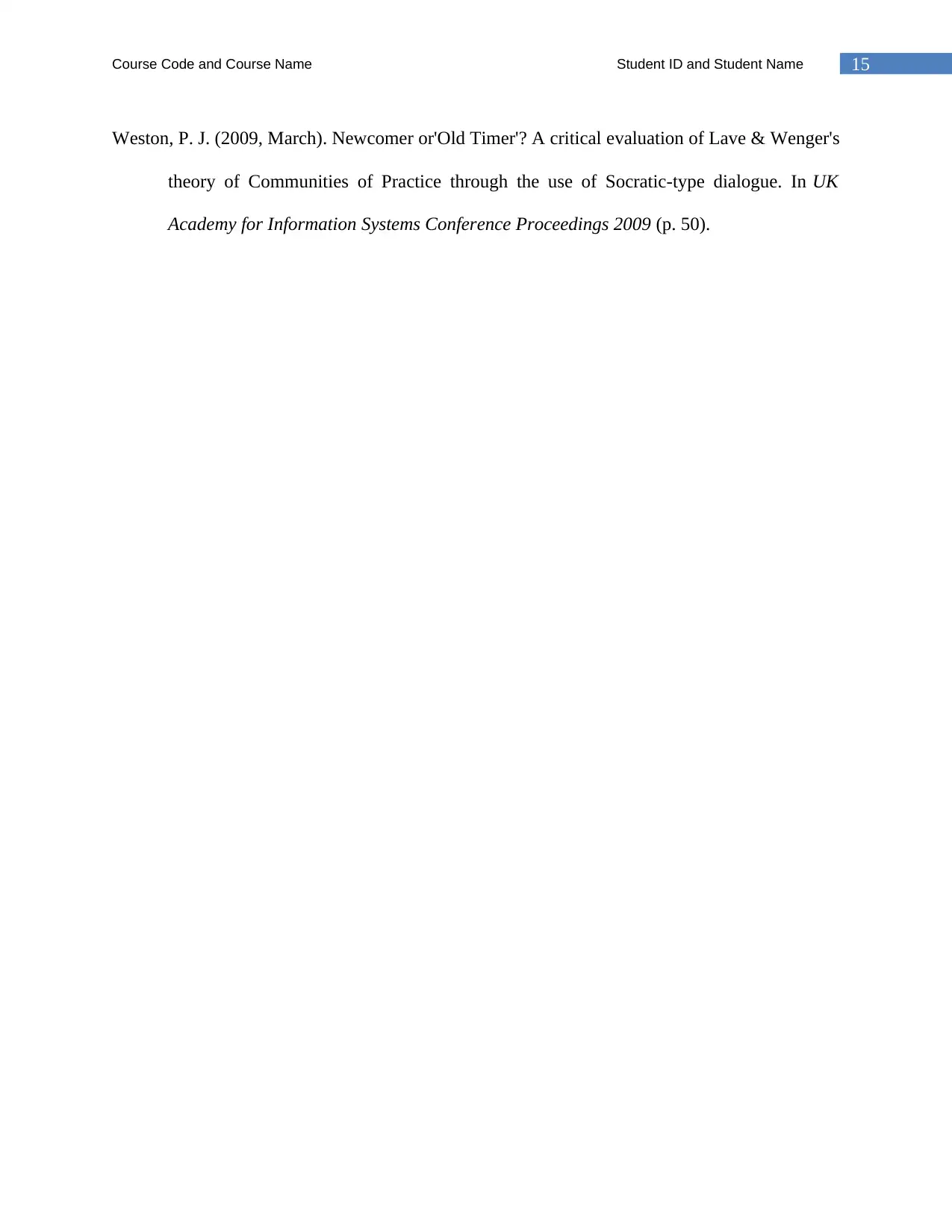
15Course Code and Course Name Student ID and Student Name
Weston, P. J. (2009, March). Newcomer or'Old Timer'? A critical evaluation of Lave & Wenger's
theory of Communities of Practice through the use of Socratic-type dialogue. In UK
Academy for Information Systems Conference Proceedings 2009 (p. 50).
Weston, P. J. (2009, March). Newcomer or'Old Timer'? A critical evaluation of Lave & Wenger's
theory of Communities of Practice through the use of Socratic-type dialogue. In UK
Academy for Information Systems Conference Proceedings 2009 (p. 50).
1 out of 16
Related Documents
Your All-in-One AI-Powered Toolkit for Academic Success.
+13062052269
info@desklib.com
Available 24*7 on WhatsApp / Email
![[object Object]](/_next/static/media/star-bottom.7253800d.svg)
Unlock your academic potential
© 2024 | Zucol Services PVT LTD | All rights reserved.




